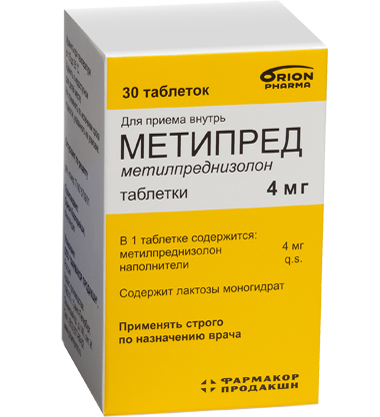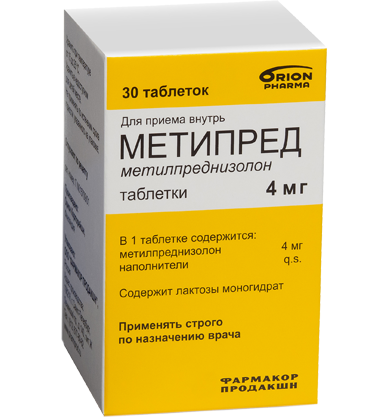Metipred


Producedon a contract
basis for «ORION CORPORATION» (Finland)
basis for «ORION CORPORATION» (Finland)
Methylprednisolone
glucocorticosteroid
tablets
Endocrine diseases
- Primary and secondary adrenal insufficiency (drugs of choice - hydrocortisone or cortisone; if necessary, synthetic analogues may be used in combination with mineralocorticoids; the addition of mineralocorticoids is of particular importance in pediatrics).
- Congenital adrenal hyperplasia.
- Chronic and subacute thyroiditis.
- Hypercalcemia in the setting of cancer.
Non-endocrine diseases
- Musculoskeletal diseases (including rheumatic)
(as additional therapy, briefly, for withdrawal from an acute condition or in case of recrudescence)- Psoriatic arthritis.
- Rheumatoid arthritis, including juvenile rheumatoid arthritis (in some cases, low-dose supporting therapy may be required).
- Ankylosing spondylitis.
- Acute and subacute bursitis.
- Acute nonspecific peritendinitis.
- Acute urarthritis.
- Posttraumatic osteoarthritis.
- Synovitis in the presence of osteoarthritis.
- Epicondylitis.
-
General connective tissue diseases
(during exacerbation or, in some cases, as supporting therapy)- Acute rheumatic heart disease.
- Systemic lupus erythematosus.
- Systemic dermatomyositis (polymyositis).
- Rheumatic polymyalgia.
- Giant cell arteritis.
-
Skin diseases
- Pemphigus.
- Herpetiform bullous dermatitis.
- Severe erythema multiforme (Stevens-Johnson syndrome).
- Exfoliative dermatitis.
- Mycosis fungoides.
- Severe psoriasis.
- Severe seborrheic dermatitis.
-
Allergic reactions
(severe or disabling conditions in case of which conventional therapy is ineffective)- Seasonal or year-round allergic rhinitis.
- Serum disease.
- Bronchial asthma.
- Hypersensitivity reactions to drugs.
- Contact dermatitis.
- Atopic dermatitis.
-
Eye diseases (severe acute and chronic allergic and inflammatory processes with damage to the eyes and their appendages)
- Allergic marginal ring ulcer of the cornea.
- Herpes zoster with eye damage.
- Inflammation of the anterior eye.
- Diffuse posterior uveitis and choroiditis.
- Sympathetic ophthalmia.
- Allergic conjunctivitis.
- Keratitis.
- Chorioretinitis.
- Optic neuritis.
- Iritis and iridocyclitis.
-
Diseases of the respiratory system
- Symptomatic sarcoidosis.
- Leffler syndrome, not responding to therapy by other means.
- Berylliosis.
- Peracute or disseminated tuberculosis in combination with appropriate antituberculous chemotherapy.
- Aspiration pneumonitis.
-
Hematologic diseases
- Idiopathic thrombocytopenic purpura in adults.
- Secondary thrombocytopenia in adults.
- Acquired (autoimmune) haemolytic anaemia.
- Erythroblastopenia (erythrocytic anaemia).
- Congenital (erythroid) hypoplastic anaemia.
-
Cancer (as supportive care)
- Leukemia and lymphoma in adults.
- Acute leukemia in children.
-
Edema syndrome
- For diuresis stimulation and to achieve remission of proteinuria in patients with nephrotic syndrome without uremia, or nephrotic syndrome of idiopathic type, or caused by systemic lupus erythematosus.
-
Gastrointestinal diseases (to withdraw the patient from a critical condition)
- Ulcerative colitis.
- Regional enteritis.
- Nervous system
- Exacerbations of multiple sclerosis.
- Cephaledema secondary to tumor.
-
Other indications
- Tuberculous meningitis with subarachnoid block or with a threat of block (in combination with appropriate antituberculous chemotherapy).
- Trichinellosis with damage to the nervous system or myocardium.
- Organ transplantation
see instructions for use